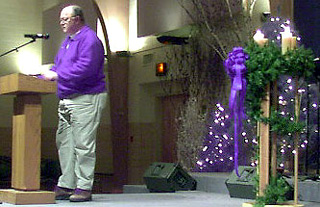 |
Consequences of Vatican II
Confession after Vatican II - Part IV
A Round-up of Changes in Word & Spirit
Fr. Stephen F. Somerville, STL
There is a variety of further theological and pastoral points to be noted in the Novus Ordo Confession, vis-á-vis the Traditional rite. These reveal changes in the customary ways and language of the Sacrament of Penance. Here are some of them:

The Seven Sacraments altarpiece, detail of Confession - Roger van der Weyden, 15th c. |
1. The term mortal sin is being replaced by grave or serious sin. The use of the word “mortal” is not forbidden. But the word mortal does clearly connote deadly or fatal, or as physicians might say, terminal. It is a healthy reminder of life’s finality after our death. It says that to leave a grave or serious sin unattended to, unrepented, is a real danger to gaining one’s final salvation in Heaven and risking one’s loss in Hell. Prudent education of our children should include this mortal-venial distinction among sins. St. John speaks – in his first Epistle 5:16-17 - of a sin that is "unto death." The meaning of this is disputed. It probably means a more serious degree of mortal sin, some very heinous sin, such as willful apostasy, or final impenitence, from which one hardly ever comes back to Christ. Let us not be complacent.
2. The new conciliar rite has changed the name Act of Contrition to Prayer of the Penitent. You see, a penitent could be saying any prayer at all, and so this new name is at least weaker, by being vague and imprecise. It is bad pedagogy to confront Catholics with that novel name, just when he or she needs to hear this deeply rooted Catholic name, Act of Contrition.
3. That most traditional Act of Contrition in English has been severely changed and weakened and “alternativized” in the official Vatican-approved (I.C.E.L.) translation into English (1975). Since such translation, the penitent is confronted by not one or two, but ten suggested acts of contrition, drawn from some variety of sources. They are not bad prayers, as far as they go. But this ten-fold variety is bewildering and ill-advised. It will weaken and not strengthen the expression penance among Catholics. I wonder, was this the conscious intention of some secret, freemasonic member of the Vatican liturgy commission?
Catholics, especially the young, need to learn a single, strong, and expressive prayer, such as we already have. I do believe that many sensible pastors are well aware of just that, and are not inflicting those ten prayers on the heads of poor sinners. Is not our usual Act of Contrition satisfactory? You know how it runs:
O my God, I am heartily sorry for having offended Thee, and I detest all my sins because I dread the loss of Heaven and the pains of Hell. But most of all because they offend Thee, my God, Who are all good and deserving of all my love. I firmly resolve, with the help of Thy grace, to confess my sins, to do penance, and to amend my life. Amen.
This prayer is quite excellent! It tells succinctly and well the difference between perfect and imperfect contrition, the nature of this sorrow, and the required acts of the penitent (these are the required “matter” of the Sacrament) for a good confession. Briefly they are: Be sorry, Confess, Do the assigned penance, and Resolve to amend. Let us all maintain this good prayer!

A priest dressed in Minnesota Vikings colors holds a communal "Reconciliation service" in Advent |
4. The fourth point to note in this Novus Ordo of Penance is the many, insistent allusions to God's mercy, with no mention of His justice. Parallel to this is the non-mention of suffering or divine punishment for sin, and, particularly, no word of Hell. The “new theology” of the conciliar church is behind this. Some of it maintains that God never punishes us (for sin), but simply allows us to suffer from the intrinsic, negative consequences of our sins. It is quite difficult to sustain this view in the face of the emphatic statements of punishment by God in the Scriptures and in Catholic tradition.
Some theologians hold further that no one goes to Hell and everyone is eventually saved. Even Satan is said by some to repent and convert in the end. Scripture surely makes this idea indefensible. The “new” theologians are getting bolder and straying further since the now-long-past Vatican Council. But the Vatican is careful to avoid the most flagrant new ideas in the liturgy prayers. Nevertheless, one is left with a lingering suspicion that the new theology did exert considerable influence on the framers of the new Penance rite.
5. Point five is the abundant provision of Scripture passages to use in this post-conciliar penance rite. These readings are a better idea in theory than in confessional practice. The chosen Scripture passages induce the use of communal celebrations of Penance. These collective rites are new. It has become common practice to have a communal penance service, once in Advent and once in Lent, in all the churches of a given pastoral zone, each on a different day for a wider choice for the penitents. This is supposed to also facilitate all the pastors helping each other at the various churches. There may be, however, a temptation for a pastor at a communal service to give communal absolution, that is, so-called General Absolution.
Let me speak briefly but firmly about General Absolution. I think it was a mistake for the Church to propose and to provide it. I think that it rapidly became an abuse. I think that the regulation of the Church, saying, “Do this only in an urgent and grave necessity,” is often ignored. I know that to spend three hours hearing individual confessions can be tedious and tiring. But such work is also an enriching and profound mercy. St. John Vianney, the saintly Curé of Ars in France, usually spent twelve and more hours a day in his confessional. He is not the only one.

The Cure of Ars spent hours a day in the confessional |
I remember when General Absolution was first permitted and done and talked about. It was the early 1970s. I took part in the ceremony with other priests in maybe two or three parishes at the most. I must observe that I always felt uncomfortable and embarrassed by such services. I never once organized such an absolution in the four or five churches where I was in charge since the 1970s.
I hope these remarks do not sound like boasting. I had all too many pastoral shortcomings, and I leave them to the mercy of the Good Shepherd, who was the namesake of two of my pastoral assignments.
Let me return to the scriptural readings provided for a penitential service. Something similar exists in the prayers and examination of conscience provided in many pocket Sunday missals to help you prepare for a good confession. My own thick Father Lasance Daily Missal has six pages for confession at the back of its 1,852 pages. I found those six pages for the first time after twelve years when I was preparing this article. I wonder how many of you have found the pre-confession pages in your own Sunday Missal? If you have not, do look for them. If your missal lacks pre-confession preparation, there exist a good number of pamphlets or booklets for this preparation.
6. We have a point six in these theological emphases in the New Order Confession service. It is the “ecclesial aspect" of penance. It is rather vague. The term ecclesia comes from the Greek word ekklesia, which means community or gathering. It seems that the ecclesial aspect of Confession really means the communal aspect. It is supposed to be the recognition that one’s personal sins, bad habits, lingering faults, and so on, can weaken or harm the church community in various ways. I prefer not to comment much on this so-called "ecclesial dimension." Time will tell what should be made of it. I trust the instincts of traditional Catholics and I see that they generally maintain the pre-conciliar personal and private customs concerning the Sacrament of Penance.
The final novelty I point out is the ecumenical dimension of Penance or Confession. This one too is hard to define. I suspect that the Vatican ecumenists are actually engaged in a broad campaign to make the Catholic Church more attractive to the world, more likable and popular, more user-friendly.
Now how do you apply this program to the practice of going to Confession, that curious old Catholic custom? How do you inveigle Protestants into trying the confessional? It might be a renovated reconciliation room with pastel colors and potted palms and face-to-face plush arm chairs. It might be found in a church with regular General Absolution, despite the prohibition of this form of absolution outside grave need. General Absolution, as they call it, is virtually the abolition of Confession.
Qualities of the Good Confession
We can now conclude our critical study of the new rite of Confession, along with some parallel remarks about the old rite. Do not forget that this shortest of all the sacraments can be achieved in some minutes, when the penitent is well prepared, and does not need spiritual direction.

A bear hug after "reconciliation" |
Speaking of a brisk manner, I find many penitents today need cautioning against verbose and rambling confession, or unduly raising matters of non-confession. We used to say that the parlor, not the confessional, was the place for lengthy discussion. I wonder if the modern custom of "confession rooms" or "reconciliation rooms" has contributed to this verbosity. I have never liked them. A soft comfy chair is not conducive to a healthy confession.
At least in the early years of the Liturgical Reform, '60s and '70s, there was in the Roman documents no mention at all of Reconciliation Rooms, much less provision or recommendation of them. As far as I know, they are a Western-world plaything, dreamed up by some armchair liturgists. I think most penitents prefer kneeling at the grill, and they do not particularly want a bear-hug from Father at the end of the rite. The moral theologians do have a traditional wisdom concerning the qualities of a good Confession. Here is the list of those qualities.
A good confession should be discreet, free and sincere; courageous, marked by shame, sorrowful; humble, truthful and open; simple, entire, and accusatory; showing readiness to obey the confessor; secret, frequent, and prompt.
Those are sixteen good qualities there. What a rich expression of the traits of a well-disposed penitent! What a panoply of Christian virtues! By studying and teaching the Gospel, we will surely absorb all of them, even though without naming them. Good Catholic teaching Sisters with the First Communion Class to prepare, back in the pre-conciliar years of Pius XII and earlier Popes, would impart most of those qualities without particularly thinking of them. So do good Catholic parents, even today, but they find more resistance, more obstacles to cope with.
Conclusion
Let me sum up our points of doctrine and theology for a conclusion. Number one, we should continue to recognize and use the term mortal sin, along with venial sin. Numbers two and three, let us maintain that valuable name “Act of Contrition,” as well as the best known and most expressive traditional formula for the prayer.
For number four, let us remember the justice of God alongside His mercy. Our point five began with reference to scripture passages about penance. It led us to a few reflections on communal penance services and general absolution. I think we re-affirmed our support for the traditional ways of the Sacrament of Penance, as explained in a good missal or a good penance pamphlet. For point six, we agree to beware of turning Confession into an ecclesial or an ecumenical exercise.
I am convinced that goodness and truth will be made more certain by the loyal observance of the Catholic traditions of the holy Sacrament of Penance.
St. Mary Magdalen, pray for us.
St. Augustine, pray for us.
St. John Mary Vianney, pray for us.

Posted September 10, 2007

Related Topics of Interest
 Confession Before and After Vatican II - Confession - Part I Confession Before and After Vatican II - Confession - Part I
 Penance or Reconciliation? - Part II Penance or Reconciliation? - Part II
 Changes in the Form of Absolution? - Part III Changes in the Form of Absolution? - Part III
 Desacrificing the Mass - Part I Desacrificing the Mass - Part I
 Desacrificing the Mass - Part II Desacrificing the Mass - Part II
 New Mass in Latin - Comments on Sacramentum caritatis New Mass in Latin - Comments on Sacramentum caritatis
 Crisis in Catechesis Crisis in Catechesis
 The Bugnini Liturgy and the Reform of the Reform The Bugnini Liturgy and the Reform of the Reform
 The Catholic Revolution: New Wine, Old Wineskins and Vatican II The Catholic Revolution: New Wine, Old Wineskins and Vatican II
 Is the Catholic Crisis Really Explained? Is the Catholic Crisis Really Explained?



|
Vatican II | Hot Topics | Home | Books | CDs | Search | Contact Us | Donate

© 2002-
Tradition in Action, Inc. All Rights Reserved
|
 |
|